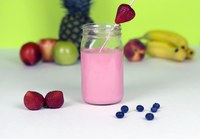Prairie Fare: Why is Vitamin D Making the News?
(Click an image below to view a high-resolution image that can be downloaded)
By Julie Garden-Robinson, Food and Nutrition Specialist
NDSU Extension
One day I was writing my “Prairie Fare” column at my desk when the phone rang.
The gentleman identified himself as a retired lawyer and mentioned the topic of a recent column I had written. He had read it in his local paper.
I missed the part about him being a “retired” lawyer.
What on earth had I written? Was I in trouble?
Good news: He wanted to talk more about vitamin D.
In my previous column, I had mentioned consuming adequate vitamin D as potentially related to immunity.
To be honest, he was more well-versed in vitamin D research than I. He had been in a vitamin D clinical trial.
He asked me if I knew what my blood level of vitamin D was.
“I don’t know,” I responded.
That isn’t a test that any health-care provider has recommended for me to date.
You may be aware of vitamin D and its many roles. Health experts have shown that adequate vitamin D, in conjunction with calcium and other nutrients, helps build and maintain our bones.
Many scientists have studied vitamin D and health, including associations with heart disease, inflammation, cancer, depression, diabetes and other diseases. We need more research in those areas.
During the current pandemic, immune system function has made the news. Researchers have connected inadequate vitamin D levels with COVID-19.
In one recent study, researchers assessed the vitamin D levels of 489 patients compared with their risk of testing positive for COVID-19. Those with a vitamin D deficiency were 1.77 times more likely to test positive for COVID-19.
A study published in September 2020 showed that adequate levels of vitamin D decreased the risk of complications and death among 235 hospitalized COVID-19 patients.
We don’t have enough evidence for a national recommendation; however, meeting your vitamin D needs certainly will not harm you.
The Institute of Medicine set the daily recommendation at 600 International Units for people from ages 1 to 69 and 800 International Units for people ages 70 and older.
Your health-care provider may recommend a higher dose, depending on your vitamin D status.
We can get adequate amounts of vitamin D through exposure to sunlight, certain foods and dietary supplements.
The action of the sun on our skin produces vitamin D in our bodies. Meeting our daily needs requires exposure of five to 30 minutes of sunlight in mid-day.
That’s easy when you are mowing the lawn, gardening, fishing, golfing or otherwise enjoying some time in the sun in short sleeves or shorts during warm months. On the other hand, we also need to be aware of skin cancer risk with too much sun exposure.
Those of us in the Midwest and other northern areas of the U.S. are more likely to be short on vitamin D than people who live in southern regions.
We “northerners” spend our winters bundled in coats, hats and scarves as we quickly move from warm vehicles to warm homes.
Exclusively breastfed infants and older adults are among those at greater risk for inadequate intake of vitamin D. Breastfeeding has many health advantages; however, exclusively breastfed infants should receive vitamin D drops, according to current recommendations from the American Academy of Pediatrics.
People with dark skin, Crohns disease or celiac disease and obese individuals also may be short of vitamin D.
Yes, this is a complex topic, especially when we consider that few foods contain a lot of vitamin D. Talk with your health-care provider about the potential need for a vitamin D supplement.
The next time you are at the grocery store or even choosing a snack from your refrigerator or cupboard at home, take a closer look at the Nutrition Facts labels. By 2021, all Nutrition Facts labels will include vitamin D. Many already list vitamin D.
The best food source of vitamin D is cod liver oil, with 170% of the daily recommendation. Not too many people consume cod liver oil these days. Perhaps you or your older relatives remember having to gulp down cod liver oil to prevent rickets.
More appetizing sources of vitamin D include trout, salmon, milk, sardines, beef liver and eggs. A cup of 2% milk provides about 15% of the daily value for vitamin D, while 3-ounce servings of trout and salmon have 81% and 71%, respectively, of the daily value. Some cereals and juice products are fortified with vitamin D.
Here’s a tasty beverage with vitamin D-rich milk and fruits rich in many vitamins and minerals to keep our bodies strong.
Fruit for the Day Smoothie
1 7-ounce can mandarin oranges (in light syrup)
2 medium-sized frozen bananas, peeled and sliced
2 c. frozen unsweetened strawberries or your favorite fruit
1 1/2 c. fat-free milk
Place ingredients in blender. Blend on low speed for 30 seconds, then on high speed for one minute.
Makes four servings. Each serving has 140 calories, 0.5 grams (g) fat, 4 g protein, 33 g carbohydrate, 3 g fiber, 55 milligrams sodium and about 6% of the daily recommendation for vitamin D.
(Julie Garden-Robinson, Ph.D., R.D., L.R.D., is a North Dakota State University Extension food and nutrition specialist and professor in the Department of Health, Nutrition and Exercise Sciences. Follow her on Twitter @jgardenrobinson)
NDSU Agriculture Communication - Oct. 1, 2020
Source: Julie Garden-Robinson, 701-231-7187, julie.garden-robinson@ndsu.edu
Editor: Ellen Crawford, 701-231-5391, ellen.crawford@ndsu.edu




